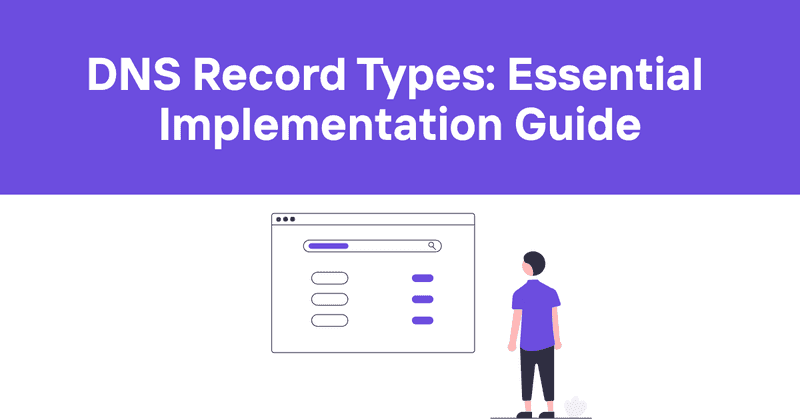DNS Record Types: Essential Implementation Guide
Introduction
DNS record types form the backbone of the Domain Name System, which powers the internet's ability to translate human-friendly domain names into machine-readable IP addresses. As a software developer who's wrangled with DNS configurations more times than I can count, I've seen firsthand how critical these records are to keeping websites and online services accessible.
Working with DNS records can be simultaneously straightforward yet surprisingly complex. Each record type serves a specific purpose in the DNS ecosystem, and knowing when and how to use each one properly can save you hours of debugging and head-scratching.
In this technical guide, I'll walk you through the most important DNS record types, explain what they do, how they work, and provide practical examples to help you understand when to use each one. Let's dive right into the technical details that matter.
Table of Contents
What is DNS?
The Domain Name System (DNS) is a hierarchical, distributed database that translates domain names into IP addresses. When you type a URL like "example.com" into your browser, a DNS resolver must find the corresponding IP address (like 93.184.216.34) before your browser can establish a connection.
DNS works through a series of queries that traverse the DNS hierarchy:
- Your device queries a recursive resolver (typically provided by your ISP)
- If not cached, the resolver queries root nameservers
- The root servers direct to the appropriate Top-Level Domain (TLD) servers
- TLD servers direct to the authoritative nameservers for the domain
- The authoritative nameservers provide the actual record data
DNS records are stored in zone files on authoritative nameservers. They contain various record types, each serving a specific function in this lookup process.
Key DNS Record Types
Let's examine the most commonly used DNS record types and understand their specific roles.
A Records
A records (Address records) are the most fundamental DNS record type. They map a domain name directly to an IPv4 address.
Format:
Example:
The "A" stands for "Address," and these records are used whenever you need to point a domain or subdomain to a specific IPv4 address. When someone types your domain into a browser, the DNS resolver looks for the A record to find where to send the request.
Practical Use Cases:
- Pointing your domain to your web server's IP address
- Creating subdomains that point to different servers (like blog.example.com)
- Setting up multiple servers for load balancing (multiple A records for the same domain)
A records only work with IPv4 addresses. If you need to use IPv6, you'll need AAAA records instead.
AAAA Records
AAAA records serve the same purpose as A records but for IPv6 addresses instead of IPv4. As IPv4 addresses are becoming scarce (there are only about 4.3 billion possible IPv4 addresses), IPv6 was developed with a much larger address space.
Format:
Example:
IPv6 addresses are written as eight groups of four hexadecimal digits, separated by colons. This format provides approximately 340 undecillion unique addresses (that's 340 followed by 36 zeros).
Practical Use Cases:
- Ensuring your website is accessible via IPv6
- Future-proofing your DNS configuration
- Meeting requirements for government or enterprise networks that mandate IPv6 support
I've found that setting up both A and AAAA records for your domains is a good practice, even if your IPv6 traffic is currently minimal. This dual-stack approach ensures compatibility as the internet continues its slow transition to IPv6.
CNAME Records
CNAME (Canonical Name) records map an alias domain name to another "canonical" domain name. Unlike A records, which point directly to an IP address, CNAME records point to another domain name, which then must be resolved to an IP address.
Format:
Example:
In this example, when someone visits www.example.com, the DNS resolver first finds this CNAME record, which points to example.com. It then needs to look up the A record for example.com to find the actual IP address.
Practical Use Cases:
- Creating a www subdomain that points to your root domain
- Setting up subdomains for services hosted by third parties
- Managing multiple subdomains that all point to the same destination
Important Limitations:
- You cannot have other records on a domain that has a CNAME record
- You cannot create a CNAME record for the root domain (apex domain)
- Chaining multiple CNAMEs together increases DNS lookup time
I often use CNAME records when working with cloud services. For example, if you're using a CDN like Cloudflare, you might need to create a CNAME record pointing your domain to their edge servers.
MX Records
MX (Mail Exchange) records specify the mail servers responsible for accepting email messages on behalf of a domain. They include a priority value to indicate the order in which mail servers should be tried.
Format:
domain.com. IN MX 20 secondary-mail-server. domain.com.
Example:
example.com. IN MX 20 backup-mail.example.com.
The number before the server name is the priority value. Lower numbers indicate higher priority. In the example above, mail.example.com is tried first, and if it's unavailable, backup-mail.example.com is used.
Practical Use Cases:
- Setting up email for your domain
- Configuring backup mail servers
- Using third-party email providers (like Google Workspace or Microsoft 365)
When setting up MX records for third-party email providers, you'll typically be given specific MX records to add to your DNS configuration. For Google Workspace, for example, you might add:
example.com. IN MX 5 alt1.aspmx. l.google.com.
example.com. IN MX 10 alt2.aspmx. l.google.com.
NS Records
NS (Nameserver) records specify the authoritative DNS servers for a domain. These are the servers that contain the actual DNS records for your domain.
Format:
domain.com. IN NS ns2.nameserver.com.
Example:
example.com. IN NS ns2.examplehost.com.
When you register a domain, you'll need to set NS records to point to your DNS provider's nameservers. When someone tries to access your domain, their DNS resolver will query these nameservers to find the other records (A, CNAME, MX, etc.) for your domain.
Practical Use Cases:
- Setting up a new domain
- Changing DNS providers
- Delegating a subdomain to different nameservers
NS records are typically managed at your domain registrar, not your DNS provider. When you want to use a specific DNS provider (like Cloudflare, AWS Route 53, or Google Cloud DNS), you'll update the NS records at your registrar to point to that provider's nameservers.
TXT Records
TXT (Text) records store arbitrary text data in the DNS. Originally intended for human-readable notes, they're now commonly used for various verification and security purposes.
Format:
Example:
Practical Use Cases:
- Domain ownership verification (for Google Workspace, Microsoft 365, etc.)
- SPF records for email authentication
- DKIM keys for email signing
- DMARC policies for email security
- Information about services associated with the domain
TXT records have become the Swiss Army knife of DNS records. If a service needs to store some data in DNS but doesn't have a specific record type, it probably uses TXT records.
One common use is domain verification. When setting up Google Workspace, you might be asked to add a TXT record like:
SOA Records
SOA (Start of Authority) records contain administrative information about the DNS zone, including the primary nameserver, the email of the domain administrator, and various timing parameters.
Format:
2023042001 ; serial
7200 ; refresh (2 hours)
3600 ; retry (1 hour)
1209600 ; expire (2 weeks)
86400 ; minimum TTL (24 hours)
Example Components:
- Primary nameserver: ns1.example.com
- Admin email: admin.example.com (note the dot instead of @)
- Serial number: Version number of the zone file, typically in date format (YYYYMMDDNN)
- Refresh: How often secondary nameservers check for updates
- Retry: How long to wait before retrying a failed zone transfer
- Expire: How long secondary nameservers should consider their data valid if they can't contact the primary
- Minimum TTL: Default time-to-live for negative responses
SOA records are usually managed automatically by your DNS provider. You rarely need to modify them directly unless you're running your own nameservers.
PTR Records
PTR (Pointer) records provide reverse DNS lookup capability, mapping an IP address back to a domain name. They're the opposite of A records.
Format:
Example:
PTR records are stored in a special reverse DNS zone, using the .in-addr.arpa suffix for IPv4 addresses or .ip6.arpa for IPv6 addresses.
Practical Use Cases:
- Email server verification (many servers check if incoming connections have valid reverse DNS)
- Logging and analytics (showing domain names instead of IP addresses)
- Server identification in network diagnostics
Unlike other DNS records, PTR records are usually not managed through your regular DNS provider. Instead, they're typically set up through your ISP or hosting provider, since they control the IP address allocation.
SRV Records
SRV (Service) records specify the location of services in a domain. They include port and priority information, making them more detailed than simple A or CNAME records.
Format:
Example:
SRV records have several components:
- Service name: Prefixed with underscore (e.g., _sip)
- Protocol: Also prefixed with underscore (e.g., _tcp)
- Priority: Similar to MX records, lower values have higher priority
- Weight: Used to distribute load among servers with the same priority
- Port: The TCP or UDP port where the service is running
- Target: The hostname of the server providing the service
Practical Use Cases:
- VoIP and SIP services
- XMPP (Jabber) chat servers
- Microsoft Active Directory services
- Minecraft servers
SRV records are particularly useful for services that don't run on standard ports or need to distribute load across multiple servers. They allow clients to discover service information through DNS rather than requiring hard-coded server addresses and ports.
Other DNS Record Types
While the record types above cover most common use cases, there are several specialized record types that serve important functions for specific scenarios.
CAA Records
CAA (Certification Authority Authorization) records specify which certificate authorities (CAs) are allowed to issue SSL/TLS certificates for a domain.
Format:
Example:
example.com. IN CAA 0 issuewild "letsencrypt.org"
CAA records have three components:
- Flags: Usually 0, can be used to mark the record as critical
- Tag: "issue" for regular certificates, "issuewild" for wildcard certificates, or "iodef" for reporting URLs
- Value: The authorized CA or reporting URL
Adding CAA records is a security best practice to prevent unauthorized certificate issuance. If you only use Let's Encrypt for your SSL certificates, you can add a CAA record specifying only Let's Encrypt is authorized to issue certificates for your domain.
DNSKEY Records
DNSKEY records store public keys used in DNSSEC (DNS Security Extensions), which adds a layer of security to DNS lookups by digitally signing DNS data.
Format:
DNSKEY records are complex and typically managed automatically by DNS providers that support DNSSEC. You generally don't need to create or modify these records manually.
DMARC Records
DMARC (Domain-based Message Authentication, Reporting, and Conformance) records specify policies for email authentication. They're actually implemented as specialized TXT records.
Format:
Example:
DMARC records include several parameters:
- v: Version (always DMARC1)
- p: Policy for the domain (none, quarantine, reject)
- sp: Policy for subdomains
- pct: Percentage of messages subject to filtering
- rua: URI for aggregate reports
- ruf: URI for forensic reports
DMARC works with SPF and DKIM to provide comprehensive email authentication. It helps prevent email spoofing and phishing by allowing domain owners to specify how to handle emails that fail authentication.
SPF Records
SPF (Sender Policy Framework) records specify which mail servers are authorized to send email on behalf of a domain. Like DMARC, they're implemented as TXT records.
Format:
Example:
SPF records consist of a version declaration (v=spf1) followed by a series of mechanisms and qualifiers:
- ip4/ip6: Authorized IP ranges
- a/mx: Use the domain's A/MX records
- include: Import another domain's SPF record
- Qualifiers: + (pass), - (fail), ~ (softfail), ? (neutral)
SPF helps receiving mail servers verify that incoming email from a domain comes from a host authorized by that domain's administrators. This reduces the risk of email spoofing and phishing attacks.
DNS Record TTL Values
TTL (Time To Live) values specify how long DNS records can be cached before the resolver needs to request fresh data. They're expressed in seconds.
Format:
In this example, the TTL is 86400 seconds (24 hours).
Considerations for TTL Values:
- Normal operations: Higher TTLs (3600-86400 seconds) reduce DNS query load
- Planned changes: Lower TTLs (300-600 seconds) before making DNS changes
- Emergency changes: Very low TTLs (60 seconds) for rapid response
- High-availability services: Balance between cache efficiency and ability to reroute quickly
When planning changes to your DNS records, it's a good practice to lower the TTL values at least 24-48 hours before making the change. This ensures that when you update the records, the change will propagate quickly.
DNS Record Management Best Practices
Managing DNS records effectively is crucial for maintaining reliable online services. Here are some best practices I've learned over the years:
-
Document your DNS configuration: Keep a record of all your DNS settings, including when and why changes were made.
-
Use consistent naming conventions: For example, use "www" instead of mixing "www" and "web" across different domains.
-
Set appropriate TTL values: Use longer TTLs for stability, shorter TTLs when preparing for changes.
-
Implement redundancy: Use multiple nameservers from different providers/networks.
-
Secure your DNS: Implement DNSSEC, use strong registrar security, and restrict who can make DNS changes.
-
Monitor your DNS: Regularly check that your DNS records are resolving correctly and watch for unexpected changes.
-
Test before deploying: Use tools like
digor online DNS checkers to verify changes before directing production traffic. -
Plan for failures: Have backup records ready and know the process to revert changes if needed.
-
Regular audits: Periodically review your DNS records to remove outdated entries and ensure everything is current.
-
Use DNS providers with API support: This enables automation and integration with your deployment processes.
Common DNS Record Problems
Even experienced developers encounter DNS issues. Here are some common problems and their solutions:
-
Propagation delays: Changes to DNS records don't appear immediately worldwide due to caching. Solution: Plan ahead and lower TTLs before making changes.
-
CNAME at root: You cannot use a CNAME record at the root (apex) of your domain. Solution: Use an A record, or look for providers that offer ALIAS/ANAME records.
-
DNS spoofing/cache poisoning: Attackers inject false DNS information. Solution: Implement DNSSEC.
-
Mismatched NS records: NS records at your registrar don't match those at your DNS provider. Solution: Ensure they match exactly.
-
Circular references: CNAME records pointing to each other. Solution: Redesign your DNS structure to avoid circular dependencies.
-
Improper delegation: Subdomain delegation issues. Solution: Ensure proper NS records for delegated subdomains.
-
Missing glue records: NS records pointing to hostnames within the same domain. Solution: Add glue records at your registrar.
-
Inconsistent MX records: Mail delivery problems due to misconfigured MX records. Solution: Ensure all MX records are properly configured with correct priorities.
DNS Monitoring
Proactive DNS monitoring is essential for maintaining reliable services. DNS issues can cause outages that are difficult to diagnose without proper monitoring.
Key aspects to monitor include:
-
Record resolution: Are your DNS records resolving to the correct values?
-
Nameserver performance: Are your nameservers responding quickly to queries?
-
TTL compliance: Are resolvers respecting your TTL values?
-
DNSSEC validation: If you use DNSSEC, is it configured correctly?
-
Unexpected changes: Has someone modified your DNS records without authorization?
Proper DNS monitoring tools should:
- Check your DNS from multiple global locations
- Alert you to any unexpected changes
- Verify all critical record types (not just A records)
- Monitor nameserver response times
- Check for expiring domains
- Validate proper DNSSEC configuration if used
Conclusion
DNS record types are the building blocks that make the internet navigable. From the fundamental A records that connect domain names to IP addresses, to specialized records like CAA that enhance security, understanding these records is essential for any developer working with web applications.
Properly configured DNS is often taken for granted until something goes wrong. By implementing the best practices outlined in this guide and staying vigilant with monitoring, you can ensure that your DNS infrastructure remains robust and reliable.
For developers managing websites and APIs, a reliable monitoring solution like Odown can be invaluable. Odown not only monitors your website and API uptime but also provides DNS monitoring to catch issues before they affect your users. Its SSL certificate monitoring feature helps prevent unexpected certificate expirations, while public status pages keep your users informed during any incidents. By combining proper DNS management with Odown's comprehensive monitoring tools, you can ensure that your online services remain accessible and reliable for all users.



